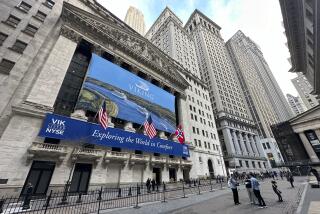Fed Raises Key Rate by a Quarter-Point
WASHINGTON — The Federal Reserve raised short-term interest rates Tuesday in an effort to keep inflation in check, noting that the economy had “regained some traction” after slowing in the spring.
The central bank’s policymaking committee, headed by Fed Chairman Alan Greenspan, said it was raising its benchmark rate on federal funds -- overnight loans between banks -- to 1.75% from 1.5%.
It was the third increase of a quarter-point since June, when the central bank reversed course after taking short-term interest rates to their lowest level since the 1950s.
Although the rate hike had been widely expected, independent analysts interpreted the language accompanying the announcement as a relatively bullish commentary on the strength of the recovery.
“This is really a vote of confidence in the economy,” said Sung Won Sohn, chief economist at Wells Fargo Bank in Minneapolis. “The Fed is basically saying the economy is improving, inflation is under control, we know what we are doing, so trust us.”
Even with the latest hike, Fed policy remains “accommodative,” the rate-setting panel said, signaling its intent to continue raising rates until they reach a more neutral level that neither stimulates nor dampens economic growth.
Although the recovery slowed somewhat in the second quarter, recent data suggested that it was regaining momentum, the Fed panel said. Even so, it added, inflationary pressures remain contained.
“After moderating earlier this year partly in response to the substantial rise in energy prices, output growth appears to have regained some traction, and labor market conditions have improved modestly,” Fed officials said. “Despite the rise in energy prices, inflation and inflation expectations have eased.”
The rate-setting committee will meet again Nov. 10 and Dec. 14. Many analysts are betting that the Fed will approve at least one more quarter-point increase by year-end, then hold off awhile to make sure the recovery remains on track.
For months, the Fed has telegraphed its intention to raise rates “at a measured pace,” meaning in small increments, to keep prices from climbing as the economy continues to recover and demand for goods and services increases.
Many economists estimate the point of neutrality to be between 3.5% and 4.5%. But some predict that the Fed will temporarily halt its upward march at about 2% to assess what effect higher interest rates, high oil prices and other negative factors are having on the economy.
Several analysts said they expected the Fed to boost rates again at its November meeting but forgo an increase in December. That would minimize the effect of rate hikes on the holiday shopping season.
On Capitol Hill, some Republicans said the time had already come to hold off on more rate increases.
“The Fed’s action today was widely expected, and I hope it completes the round of interest rate increases this year,” said Rep. Jim Saxton (R-N.J.), vice chairman of the Joint Economic Committee. “Leading market price indicators of inflation are well under control, and so long as this is the case there is no pressing need for further Fed action in the near future.”
Although some political analysts have questioned the Fed’s enthusiasm for boosting rates during an election year, the central bank has given no sign that politics has affected its timing. Tuesday’s meeting was the last before the Nov. 2 election.
If anything, the Fed probably felt it would have caused more market disruption and public concern by not raising rates than by raising them, said Brian Wesbury, chief economist at the Chicago investment banking firm of Griffin, Kubik, Stephens & Thompson. That’s because holding off on rate hikes might have been interpreted as a signal that the economy was in trouble.
“They would have been the disruptive force they try so hard not to be,” Wesbury said.
The Fed’s action applies only to short-term interest rates. Long-term rates, such as those on most fixed-rate mortgages, are subject to market forces and have already risen from last year’s lows, although they have declined in recent weeks.
Still, Tuesday’s rate hike will affect various forms of consumer and business borrowing tied to short-term rates, including adjustable-rate mortgages, home equity and auto loans, and some credit card accounts. Major banks Tuesday raised their prime lending rate -- to which many of those loans are pegged -- to 4.75% from 4.5% in tandem with the Fed’s move.
A new study by the liberal Center for American Progress calculated that the average household’s annual debt payments would increase between $194 and $299 if interest rates rose by 1% across the board.
Rising interest rates are likely to push some households into bankruptcy and cause many others to cut back on spending, creating a drag on the economy at a point when job and income growth are not strong enough to make up the difference, said Christian Weller, a senior economist who prepared the study.
“Without strong employment and wage gains, it will definitely put a substantial damper on economic growth,” Weller said. “We need to change from debt-driven consumption to income-driven consumption. That has not happened yet.”
More to Read
Inside the business of entertainment
The Wide Shot brings you news, analysis and insights on everything from streaming wars to production — and what it all means for the future.
You may occasionally receive promotional content from the Los Angeles Times.







